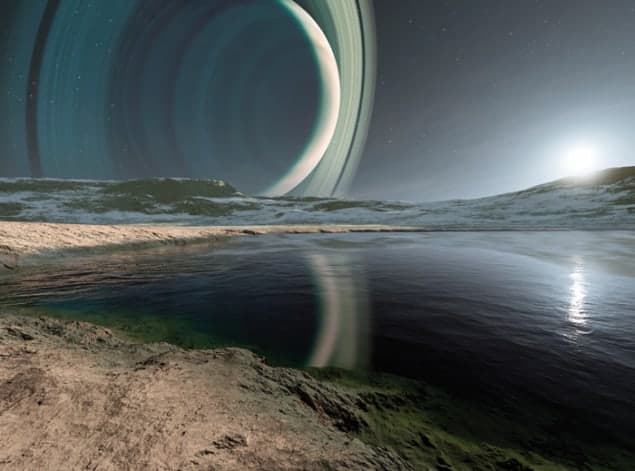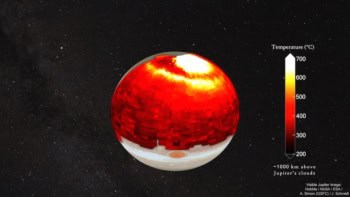Taken from the 25th anniversary issue of Physics World, this article examines one of the five biggest unanswered questions in physics as selected by the magazine’s editors
From finding unusual creatures on Earth to spying life’s building blocks beyond our solar system, Ray Jayawardhana examines what we know about the nature of life’s uniqueness, and the possibility of its existence in faraway realms such as extrasolar planets

Talk about going down a rabbit hole. There I was bent nearly in half, not quite on my knees, crawling through a narrow tunnel barely four feet tall that sloped down at a steep angle. Donning blue-grey overalls, waterproof boots and a hard hat with a miner’s lamp, I trod carefully to avoid catching myself on the sharp bits of rock protruding from all sides of the poorly lit, claustrophobic cavity. The sweltering heat and stifling humidity made breathing a chore, but I was not going to complain. It was a privilege to join Tullis Onstott and Maggie Lau of Princeton University, and Tom Krieft of the New Mexico Institute of Mining and Technology, on this scientific adventure. Nearly two kilometres underground, we were deep inside an active gold mine located near Johannesburg, South Africa. Our mission: to collect samples of ground water seeping through cracks in the bedrock, which Onstott’s team would later examine for living organisms that thrive where the Sun never shines.
In deep places of the Earth such as these, Onstott’s team and others have identified varieties of bacteria that challenge what we thought we knew about biology. Rather than relying directly or indirectly on photosynthesis, they instead feed off hydrogen gas and exist in underground ecosystems that have been totally disconnected from the biological cycles on the Earth’s surface for possibly tens of thousands of years. In 2011 Gaetan Borgonie from the University of Ghent in Belgium and his colleagues spotted roundworms (nematodes) living kilometres below ground level in several South African mines – the first multicellular organisms to be recovered from such depths. These discoveries have extended the biosphere of our planet considerably – and added to its biomass. But more interesting still, they might even provide clues to the biology of the early Earth before the evolution of photosynthesis, or to the nature of life on other worlds that have a different atmospheric make-up from our own.
Extreme beings
Organisms found in the deep subsurface of the Earth are among the many so-called “extremophiles” that scientists have come across over the past few decades. Others include microbes that live close to volcanic vents on the ocean floor, or on salt flats near the Red Sea. Yet more are found beneath the permafrost of the Canadian Arctic, within parched soils of the Atacama Desert in South America and even at the edges of the stratosphere. The very existence of these creatures affirms that life is a hardy phenomenon, capable of adapting to a remarkable range of environmental conditions.
Still, despite their magnificent and bewildering variety, all of these organisms are intimately connected to each other: they share the same biochemistry, inhabit the same evolutionary tree and trace their origins to a common ancestor that probably existed over three billion years ago. But to date, scientists have not uncovered a “shadow biosphere” on Earth, comprised of a radically different sort of life. Nor have they found compelling evidence of extraterrestrial life – yet.

What researchers have done is to confirm that the ingredients of life, as well as potential habitats, exist beyond the Earth and are ubiquitous in our cosmic neighbourhood. Laboratory measurements show that amino acids – building blocks of proteins – are common in meteorites and comets. Some carbon-rich meteorites even contain components of DNA called nucleobases. Astronomical spectroscopy at optical, infrared and radio wavelengths has revealed a number of complex organic molecules in interstellar gas clouds – the birth sites of stars and their planetary retinue.
Closer to home, our neighbouring world Mars remains a prime target in the search for life beyond Earth, with growing evidence of past water flows raising the prospect of habitability sometime in its history. Likewise, the big moons of Jupiter and Saturn, especially those that might harbour subsurface oceans, continue to intrigue us.
Beyond our solar system
In recent memory, the most dramatic development in the quest to understand our place in the universe has been the identification of thousands of planets orbiting stars other than the Sun, known as extrasolar planets, or exoplanets. Using ground-based telescopes and spacecraft such as NASA’s Kepler observatory, astronomers commonly find such alien worlds by measuring a star’s wobble as unseen planets tug on it, or by registering a star’s periodic dip in brightness as a planet transits in front of it. That is a big change from merely 20 years ago, when we were certain of just one planetary system – our own. The pace of discovery has been astounding and the incredible diversity of worlds has surprised us many times over.
What is more, thanks to a suite of remarkable new instruments, we have taken the temperature of distant planets, espied water in their atmospheres and even captured the first direct pictures of alien worlds. A number of “super-Earths” have been found already – those more massive than Earth but less so than our ice giants Uranus and Neptune – and astronomers expect to find Earth-sized planets by the dozen within the next few years. Some of these will likely be in the so-called habitable zone, where the temperatures are just right for liquid water. That will inevitably bring questions about alien life to the fore. But detection will not come easy. It will take a new generation of telescopes to pin down molecules that we associate with life – such as oxygen, ozone, methane, water and carbon dioxide – in the atmosphere of a distant terrestrial world. Even if and when we succeed in identifying such telltale signs of life, we probably will not know for a while what sort of creatures might inhabit that world.
The Earth is special among its siblings in the solar system as the only planet with surface oceans and life on a planetary scale. However, it seems absurd, if not arrogant, to think that ours is the only life-bearing world in the galaxy, given hundreds of billions of other suns, the veritable cornucopia of planets and the apparent abundance of life’s ingredients. It may be that life is fairly common, but “intelligent” species are not. In any case, as the history of science has proven time and again, generalizing from a single instance often leads to misguided, if not dangerous, conclusions. So we will have to find at least one other example of life elsewhere before we can discern what is and is not unique about life on this precious bit of reformed cosmic debris.



